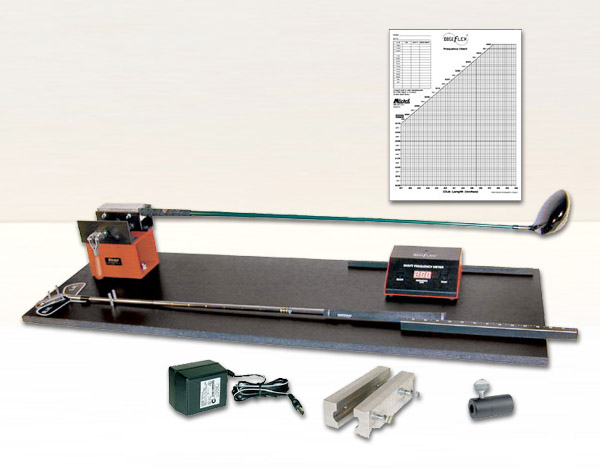Club Frequency Matching
Frequency is defined as the shaft “flex feel” of each club to the golfer. It is determined by the flexing characteristics of the club shaft. Frequency is a proven and accepted method of club assembly. Which can provide golfers with a set of irons or woods that will best control trajectories. The “frequency” of an assembled club is measured in CPM (Cycles Per Minute) on a special machine called a “frequency analyzer”.
Why Test Frequency?
We test for frequency, because not all shafts that are marked “stiff” are really stiff. Consequently, not all shafts marked “regular” are necessarily regular. This is true for all of the “stiffness” letter markings. The inconsistency can occur with both graphite and steel shafts, however, it appears more prevalent with graphite shafts.
Frequency Analyzer Machine
A club frequency analyzer measures the stiffness of shafts through what is called “shaft frequency measurement”. This pertains specifically to club oscillation. The stiffer the shaft – the faster the rate of oscillation. The more flexible the shaft – the slower the rate of oscillation. The frequency analyzer is designed to count the oscillation rate in the form of “cycles per minute” (a numerical value of CPM’s). CPM’s provide a concrete data comparison between different shafts as well as industry standard benchmarks.
The frequency reading of the shafts in a club set will normally increase from longest to shortest club in the set. However, due to many factors, the amount of increase from shaft to shaft is not normally in the exact same increment. Frequency does not pertain to club height. It directly applies to shaft flex and the rate of oscillation as measured in CPM’s because that is what the analyzer measures.
Frequency Matching a Set of Clubs
The process of “frequency matching” is a straightforward concept. At Better Golf Shot, we can match a new set, or retrofit an old set of clubs.
It involves a club set made with the incremental increases in frequency from longest to shortest clubs in the set. Consequently, the “stiffness” will be precisely feel the same from club to club.
Frequency matching improve the progression of butt-end (grip end) stiffness. The stiffness from club to club will be more consistent from longest to shortest clubs in a set.
However, the golfer’s set of clubs should be fit properly to the golfer in terms of shaft flex, weight, and bend point. Otherwise, frequency matching will not make major improvement in club performance. So, it becomes absolutely necessary to properly fit these characteristics to the average golfer along with frequency matching. Yes, we did mention flex again. Shaft flex is matched to a person based upon their individual swing speed.
We do offer this frequency matching service along with properly fitting shaft weight, flex, and bend profile. Our machine analyzer is a valuable tool to consistently measure shaft frequency. It works for both assembled clubs and raw shafts. Frequency Matching does differ from MOI Speedmatching and Shaft Puring. Albeit, these topics are often intertwined and misunderstood.
